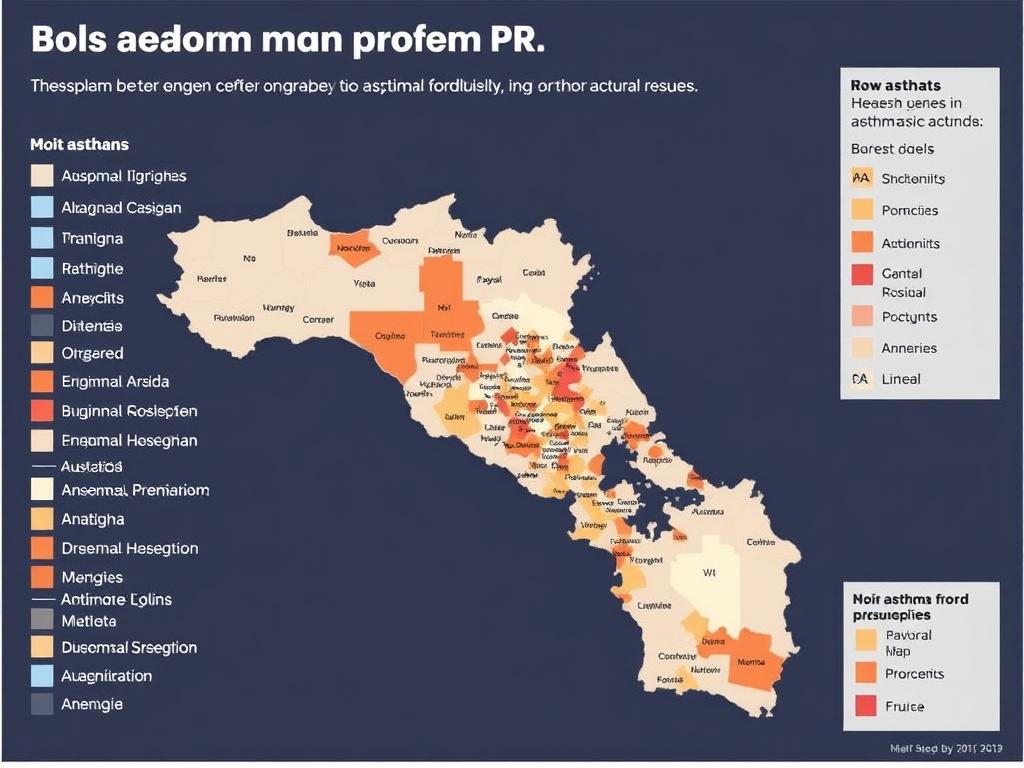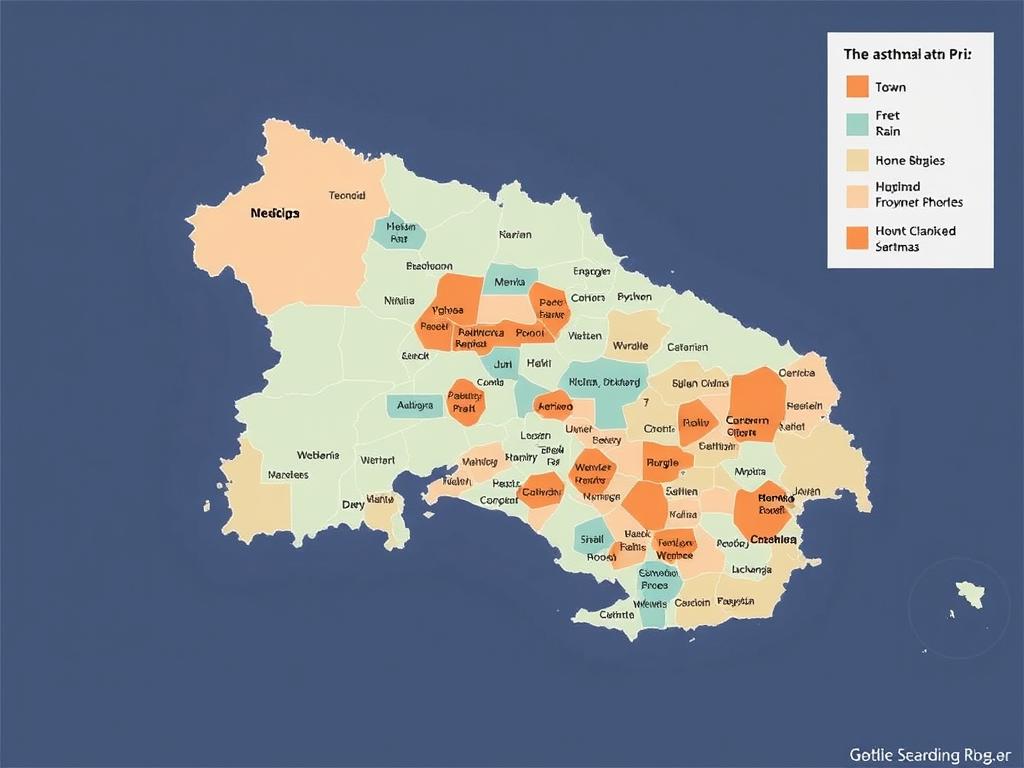Asthma is a chronic respiratory condition that affects millions of people worldwide, and Puerto Rico is no exception. In fact, asthma has been a significant public health concern on the island for decades. Understanding the distribution of asthma cases across different towns in Puerto Rico can help in targeting resources, improving healthcare, and ultimately reducing the burden of this disease. So, what does the mapa del asma en PR tell us? Which pueblos have the most asthma cases, and what factors might influence this distribution? Let’s explore.
Understanding Asthma: A Quick Overview
Before jumping into the specifics of asthma cases in Puerto Rico (PR), it’s important to understand what asthma really is. Asthma is a chronic lung disease that inflames and narrows the airways, leading to difficulty breathing. Symptoms often include wheezing, coughing, chest tightness, and shortness of breath, especially when exposed to certain triggers like allergens, pollution, or cold air.
Asthma is often managed through a combination of medication and lifestyle adjustments, but when poorly controlled, it can severely impact a person’s quality of life. In Puerto Rico, asthma is more common than in many other parts of the United States, largely due to environmental and social factors.
The Landscape of Asthma in Puerto Rico
Over the years, researchers and health officials have mapped out the prevalence of asthma throughout PR, creating an invaluable resource—the mapa del asma en PR. This map highlights the variation in asthma rates by pueblo (town), revealing clusters of high prevalence. But why do some towns experience more asthma cases than others?
Factors Influencing Asthma Distribution
Several factors contribute to the pattern of asthma cases across Puerto Rico’s pueblos:
- Environmental Conditions: Pollen from local vegetation, environmental pollutants, and industrial emissions can elevate asthma cases. Coastal towns may experience different allergens compared to mountainous regions.
- Socioeconomic Status: Poverty and limited access to healthcare can affect asthma diagnosis and management, often making cases more severe or less controlled.
- Housing Quality: Poorly ventilated or mold-prone homes increase asthma triggers.
- Weather and Climate: Puerto Rico’s tropical climate with high humidity levels can exacerbate asthma symptoms.
Which Pueblos in Puerto Rico Have the Most Asthma Cases?
The mapa del asma en PR reveals that asthma prevalence is not uniformly distributed throughout the island. Certain pueblos stand out as hotspots for higher asthma rates. Here is a table summarizing the pueblos with the highest recorded asthma cases based on recent public health data:
| Pueblo | Asthma Prevalence (%) | Notes |
|---|---|---|
| Bayamón | 18.2 | Urban area with industrial activity; air pollution is a significant factor. |
| Carolina | 17.5 | Near the airport and industrial zones; exposure to pollutants is common. |
| San Juan | 16.8 | The capital city has dense population and traffic-related pollution. |
| Caguas | 15.9 | Urban and suburban mix with some agricultural zones. |
| Ponce | 15.3 | Large urban center with historical industrial sectors; also subject to dust storms. |
Interpreting the Data
As you can see, the pueblos with the highest asthma prevalence tend to be urban or semi-urban areas with significant industrial activity or heavy traffic congestion. This trend aligns with studies from around the world showing a clear link between air pollution and increased asthma cases. This correlation suggests that environmental management, pollution control, and access to medical care in these areas could play a key role in combatting asthma.
Lower Prevalence Areas: Rural Towns with Fewer Cases?
Interestingly, many of the rural pueblos in Puerto Rico report lower asthma rates. However, these numbers can sometimes be misleading due to underreporting or limited access to healthcare professionals capable of diagnosing asthma properly.
Some rural pueblos with lower recorded asthma prevalence include:
- Añasco
- Maricao
- Las Marías
- San Sebastián
While the environmental air quality in these mountain or agricultural towns may be better, factors like exposure to agricultural chemicals or lack of treatment facilities could still pose health risks.
Challenges with Rural Healthcare
Even though asthma might appear less common in rural pueblos, residents often face barriers that complicate asthma management:
- Fewer healthcare facilities and specialists
- Longer travel distances to obtain medication or medical help
- Lack of education about asthma and its treatments
These challenges can potentially lead to worse outcomes, despite lower reported prevalence.
Environmental and Socioeconomic Factors at Play
Puerto Rico’s unique geography and socioeconomic landscape heavily influence where asthma cases concentrate. Here are some key points:
Air Pollution and Industrial Zones
Many of Puerto Rico’s urban centers are close to industrial zones and busy highways. Bayamón and Carolina, for instance, border areas with factories, oil refineries, and intense traffic, increasing exposure to harmful pollutants like nitrogen dioxide, particulate matter, and volatile organic compounds.
Housing and Urban Density
High housing density can lead to overcrowded living conditions, which increase the likelihood of indoor allergens such as cockroaches, mold, and dust mites—major asthma triggers. Furthermore, older or poorly maintained buildings often have moisture problems, fostering mold growth.
Access to Healthcare
Access to proper medical care is uneven across Puerto Rico. Urban residents tend to have better hospital access but may also face overstretched healthcare systems. Conversely, rural patients may struggle to find specialists or pharmacies that stock asthma medications.
Key Populations at Higher Risk
Asthma disproportionately affects certain groups within Puerto Rico:
- Children: Asthma is one of the leading chronic conditions among Puerto Rican children, who experience higher rates of hospitalization compared to other ethnic groups in the U.S.
- Low-income Communities: Limited resources can mean poorer housing, less access to healthcare, and higher exposure to environmental triggers.
- Residents Near Polluting Sources: Proximity to factories, highways, or power plants raises the risk of developing or worsening asthma symptoms.
Strategies to Combat Asthma in High-Prevalence Pueblos
With the mapa del asma en PR highlighting towns with higher asthma burdens, steps can be taken to mitigate this growing public health issue:
Improving Air Quality
Efforts to regulate emissions from factories and increase green spaces can improve air quality. Encouraging the use of cleaner alternatives to diesel transport and promoting public transit can reduce traffic pollution.
Enhancing Healthcare Access
Expanding asthma education programs in schools, increasing the number of healthcare providers trained in asthma care, and making medications affordable and available throughout all pueblos is vital.
Promoting Healthy Housing
Programs that assist families in repairing homes to reduce mold, improve ventilation, and remove allergens can reduce asthma triggers for vulnerable populations.
Community Awareness and Support
Educating communities about managing asthma, recognizing warning signs, and reducing exposure to triggers empowers individuals and families to take control of their health.
The Role of Local Government and Organizations
Multiple stakeholders, including Puerto Rico’s Department of Health, non-profits, and community groups, play critical roles in managing asthma. By leveraging the mapa del asma en PR, they can focus resources on pueblos with the highest need.
Key functions include:
- Conducting regular asthma surveillance to update the map and track trends.
- Launching targeted public health campaigns in high-prevalence areas.
- Partnering with schools and community centers to provide education and screenings.
- Advocating for environmental regulations that reduce pollutant exposure.
What Can Individuals Do?

If you or a loved one suffers from asthma, understanding your local environment and risk factors is crucial. Here are practical measures you can take:
- Keep indoor air clean: Use dehumidifiers, avoid smoking indoors, and clean regularly to minimize dust and mold.
- Know your triggers: Whether pollen, pet dander, or smoke, identifying triggers helps avoid flare-ups.
- Follow medical advice: Take medications as prescribed and keep regular checkups.
- Advocate: Participate in community efforts to improve air quality and asthma resources in your pueblo.
Summary Table: Asthma Prevalence and Contributing Factors by Pueblo
| Pueblo | Asthma Prevalence (%) | Primary Environmental Factors | Socioeconomic Notes |
|---|---|---|---|
| Bayamón | 18.2 | Industrial pollution, traffic emissions | Urban, mixed-income neighborhoods, some low-income areas |
| Carolina | 17.5 | Airport proximity, industrial zones | Urban, higher poverty pockets |
| San Juan | 16.8 | Traffic, urban density | Capital city, diverse socioeconomic statuses |
| Caguas | 15.9 | Urban sprawl, suburban pollution | Mixed urban and rural communities |
| Ponce | 15.3 | Industrial sectors, dust storms | Urban with historical industrial areas |
| Maricao | 7.1 | Mostly rural, clean air | Small population, limited healthcare access |
Future Outlook: How Can Puerto Rico Reduce Asthma Rates?
Asthma remains a challenging condition, but with targeted efforts based on the mapa del asma en PR, Puerto Rico can make meaningful strides. Some promising directions are:
- Enhanced Asthma Surveillance: Continuous data gathering enables responsive action where asthma rates rise.
- Green Infrastructure Projects: Increasing urban trees and parks can enhance air quality.
- Improved Public Transportation: Reducing reliance on personal vehicles can cut down pollution.
- School Health Programs: Early education for children helps prompt asthma diagnosis and management.
- Policy Advocacy: Strengthening environmental laws that prevent industrial pollution is essential.
Personal Stories: Asthma in Puerto Rico

Many Puerto Ricans living in high-prevalence pueblos share stories about the impact of asthma. From children missing school to adults struggling with daily tasks, asthma affects real lives deeply. Their voices highlight why understanding the mapa del asma en PR is not only a matter of numbers but a call to action.
An Example
Maria, from Bayamón, explains how her son’s asthma worsened during heavy traffic days near their home, particularly in the mornings. She has become an active member of a local advocacy group seeking better air quality controls and school asthma programs. Stories like hers underline the urgency for concerted efforts.
Using the Mapa del Asma en PR as a Tool
For healthcare providers, policymakers, and community leaders, the mapa del asma en PR is invaluable. It translates complex data into a clear visual representation of the island’s asthma challenges. This tool allows for:
- Effective allocation of resources to pueblos that need them most.
- Evaluating successes or failures of asthma interventions over time.
- Engaging the public with accessible information.
How You Can Access the Map
Various government and health organizations provide this information online. Checking the latest mapa del asma en PR can help residents stay informed and empower communities to take preventative action.
Conclusion
The mapa del asma en PR paints a clear picture: asthma is unevenly distributed across Puerto Rico’s pueblos, with urban centers like Bayamón, Carolina, San Juan, Caguas, and Ponce experiencing the highest rates. Environmental factors such as industrial pollution, traffic congestion, and indoor allergens play crucial roles alongside socioeconomic challenges and healthcare access disparities. While rural pueblos appear to have lower asthma cases, issues like underdiagnosis and limited healthcare suggest a more complex reality. Moving forward, Puerto Rico must focus on improving air quality, expanding healthcare and education, promoting healthy housing, and engaging community efforts in the towns most affected. Through these multifaceted strategies and continuous use of the asthma map, the island can work towards reducing the burden of asthma, enhancing quality of life, and ensuring healthier air and homes for all its residents.
